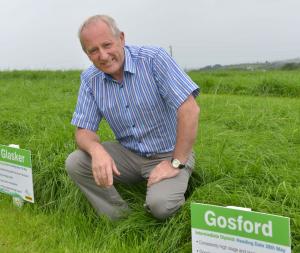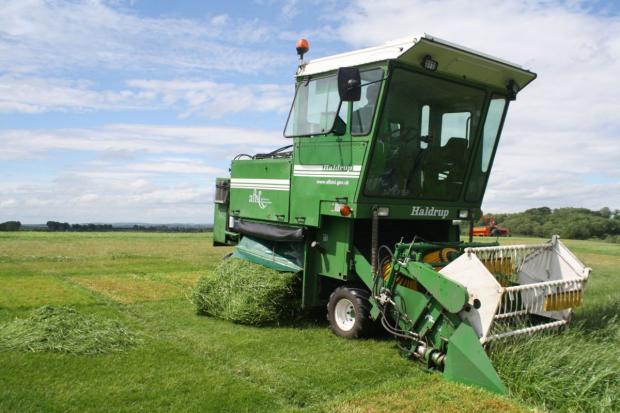Northern Ireland dairy farmers have a distinct advantage over most of their European counterparts with the ability to grow large quantities of quality grass.

Although many farms make maximum use of grass for grazing and silage, grass remains under-exploited in terms of production and utilisation and the production of milk from forage has steadily declined over the last ten years. Research work at AFBI Hillsborough has shown that for each 1000 litre increase in milk from forage, profit per cow increases by £120.
Maximising grassland output per hectare under Northern Ireland conditions is largely dependent upon well managed perennial ryegrass swards. However, NI Farm Census statistics show that the area of grassland under five years old has steadily declined in recent years. It is well proven that old ‘worn out’ swards show a poor response to fertiliser, compared to a new reseed, producing lower yields of forage of inferior nutritional quality.

Many of the grass varieties which are used on farms throughout Northern Ireland have been bred by the AFBI at Loughgall in Co Armagh. The breeding programme has been in existence since 1952 and for the last twenty five years has been jointly funded by DAERA and the Dutch seed company Barenbrug. Well known varieties, including Navan, Spelga, Tyrella and Portstewart, have contributed significantly to pasture production on farms throughout the UK, Republic of Ireland, and further afield.
The AFBI Grass Breeding programme is very extensive, with over 10ha of plots at Loughgall and further testing of new varieties and breeding lines is carried out by Barenbrug on sites across the UK and continental Europe. Grass breeding material used by AFBI is of very diverse background, and many of the varieties currently in use have been bred from parent grass plants from indigenous Irish material, winter-active material from New Zealand, winter-hardy varieties from Eastern Europe and disease resistant lines from France.
Grass breeding is a slow and expensive process, taking up to 15 years at a cost of around half a million pounds per variety. The basic principles are similar to those used in cattle breeding, with initial crosses made between pairs of selected mother plants under controlled conditions. The objective is to combine the favourable characteristics of both parents. Subsequently the progeny of these crosses is evaluated, initially by visual assessment of individual plants, then in small plots on several sites. Harvesting is with specialist equipment, which can accurately calculate yield and samples are processed through the laboratory to determine herbage quality. As with any plant breeding programme, large numbers of individual plants, progenies and varieties are evaluated but only a very small number ever make it through to the marketing stage. The final hurdle in this process is to have varieties independently assessed on several sites in the UK and Ireland for possible admission to Recommended Lists.
Breeding Objectives
When the programme was initially established at Loughgall, the main objective was to produce persistent high yielding varieties for grazing and conservation. At that time, grass seed was an important crop on many farms in Northern Ireland and the seed producing ability of a new variety was therefore an important breeding objective. However, much has changed during the last 65 years, including the disappearance of grass seed production from local farms. Nowadays, the breeding focus is on total yield under silage and grazing, early spring growth, disease resistance, herbage quality and winter hardiness.
Disease Resistance
Foliar diseases are becoming an increasing problem on farms throughout Ireland and have a detrimental effect upon both sward production and palatability. In higher rainfall areas, such as Fermanagh and West Tyrone, leaf-spot poses a serious threat, while in drier, eastern parts of the country, crown rust, which is distinguished by orange pustules, is increasingly evident. In England, disease resistance is already an important characteristic when selecting varieties for a re-seed and this is likely to become a big issue on Northern Ireland farms in the future.
In order to breed disease resistant varieties, AFBI evaluates all new breeding material with Barenbrug in France and the Netherlands, where foliar diseases are widespread. The results of these trials are combined with data from Loughgall, so as to identify high yielding, disease resistant plants which can then be used in the crossing programme. This approach has allowed the breeding of varieties such as Rosetta and Dromara, which have both high rust resistance and good yield.
Herbage Quality
Considerable effort has been invested by AFBI into breeding for improved digestibility at every stage in the breeding programme, as highly digestible forage produces more meat and milk. Selecting grasses which produce fewer seed heads in mid season, has been a key aspect of this, supported by laboratory analysis. A plot harvester, recently acquired by AFBI, has been fitted the latest cutting edge technology, a Near Infra Red Spectrometer (NIRS), which enables field assessment of dry matter, protein, soluble carbohydrates and fibre content. An important aspect of herbage quality is palatability, as this is the main parameter driving animal intake. Consequently all new AFBI varieties are trialled on local farms, where their performance under grazing can be monitored. Work carried out by Teagasc in the Republic has shown that several AFBI varieties, including Dunluce and Drumbo are particularly well grazed by dairy cows throughout the season.
Hybrids
Hybrid grasses are produced by crossing an Italian ryegrass with a perennial. Some hybrids express the characteristics of the Italian parent very strongly, producing very high yields of up to 20 tonnes per hectare. Other hybrids, such as Foyle and Drumlin, are very persistent, consistently producing high yields over many years and showing rapid recovery after cutting. These varieties are particularly well suited to local farms which are using zero-grazing or anaerobic digestion.
White Clover
The clover programme at Loughgall is a joint venture between AFBI, Barenbrug and two New Zealand companies. New varieties are tested under simulated cattle and sheep grazing and the aim is to find persistent, productive varieties which have a long growing season. Several successful varieties, including Crusader and Barblanca, have been developed using this approach.
The Future
New research on the more fundamental aspects of plant breeding is also being undertaken by AFBI, through funding from DAERA. This includes the use of Digital imaging for disease assessment and the possible adoption of molecular techniques for Genetic Marker Technology. Continued investment in the programme, strongly enhanced by the connection with the commercial sector, will ensure a steady supply of new grasses and clovers which can meet the ever changing demands of local dairy farms.
Notes to editors:
AFBI carries out high quality technology research and development, statutory, analytical, and diagnostic testing functions for DAERA and other Government departments, public bodies and commercial companies.
AFBI's Vision is “Scientific excellence in Northern Ireland … serving the world”.
All media enquiries to AFBI Press Office
Latest news
- AFBI issues Nematodirus warning – Spring 2025 11 April 2025
- Managing Nature Based Risks to the UK Economy and Opportunities for Green Finance 08 April 2025
- AFBI Hillsborough host AERA committee 27 March 2025
- The Omics Days Conference 27 March 2025
